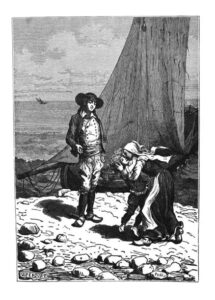Robinson Crusoe by Daniel Defoe:
“Robinson Crusoe” is a novel by Daniel Defoe and published in 1719. It tells the story of a man named Robinson Crusoe who is stranded on a deserted island for 28 years after a shipwreck. Crusoe learns to survive on the island by making tools, shelter, and growing crops. Eventually, he encounters another survivor, Friday, whom he befriends and teaches English. Crusoe and Friday are eventually rescued and return to civilization.
About the Author:
Daniel Defoe is widely recognized as one of the earliest and most influential writers of English Fiction. His most famous work, “Robinson Crusoe” (1719), is often cited as the first English novel and remains a classic of world literature.
Defoe’s fiction was groundbreaking in many ways. Unlike earlier writers of fiction, who tended to focus on aristocratic characters and settings, Defoe wrote about the experiences of ordinary people, often drawing on his experiences as a merchant, journalist, and political activist.
In addition to “Robinson Crusoe,” Defoe’s other major works of fiction include “Moll Flanders” (1722), “A Journal of the Plague Year” (1722), and “Roxana” (1724). These works are known for their vivid, realistic depictions of life in 18th-century England and their complex, morally ambiguous characters.
Clarity, directness, and realism are the characteristic features of Defoe’s writing style. He was a master of the first-person narrative, and his works are often structured as memoirs or journals. His writing is notable for its attention to detail, particularly describing characters’ physical world and day-to-day routine.
Daniel Defoe’s contribution to the growth of English fiction cannot be overstated. His works set the stage for the novel as a literary form, and his influence can be seen in the works of countless writers who followed in his footsteps.
Introduction to the Novel:
“Robinson Crusoe” is a classic novel by Daniel Defoe published in 1719. It is widely regarded as one of the earliest examples of the English novel and has had a lasting impact on literature and popular culture.
The story follows the adventures of Robinson Crusoe, a young man who defies his family’s wishes and sets out to sea in search of adventure. However, his journey suffers a setback when his ship is wrecked in a storm, leaving him stranded on a deserted island.
Alone and without hope of rescue, Crusoe must learn to survive in his harsh new environment. He builds a shelter, hunts for food, and gradually lives in isolation. Over the years, he faces numerous challenges, including encounters with hostile natives and the arrival of other shipwrecked survivors.
As Crusoe struggles to build a new life on the island, he also grapples with questions of faith, morality, and the nature of civilization. Through his experiences, he undergoes a profound personal transformation, ultimately finding redemption and a renewed sense of purpose.
In the end, Robinson Crusoe is finally rescued from the deserted island where he has been stranded for 28 years. A passing ship arrives on the island, and Crusoe and his companion, Friday, are rescued and taken aboard. They sail back to England, where Crusoe is reunited with his family and returns to civilization after his long ordeal of survival on the island.
Conclusion:
The novel concludes with Crusoe reflecting on his experiences and expressing gratitude for his rescue, while also acknowledging the profound impact that his time on the island has had on his life. Robinson Crusoe is a gripping adventure story but a meditation on the human condition and the power of resilience in the face of adversity. It has captured the imagination of readers for centuries and continues to be celebrated as a timeless classic of world literature.
Significant Characters in the Novel:
In “Robinson Crusoe,” there are several important characters besides the protagonist, Robinson Crusoe himself:
- Friday: A native man whom Crusoe rescues from cannibals. Friday becomes Crusoe’s loyal companion and assists him in various tasks on the island. Their relationship symbolizes the theme of friendship and companionship across cultural boundaries.
- Man Friday’s father: Although unnamed in the novel, he is the leader of the cannibalistic tribe from which Friday is rescued. His presence underscores the dangers Crusoe faces on the island and adds to the novel’s themes of survival and colonialism.
- Xury: A young Moorish boy, Crusoe rescues from a slave ship early in the novel. Xury becomes Crusoe’s servant and companion until they are separated during a conflict with pirates. Xury’s character highlights themes of slavery, loyalty, and survival.
- The Portuguese captain: The captain of the ship that rescues Crusoe from the island near the end of the novel. He is a benevolent figure who helps him return to England. The captain’s appearance marks a turning point in Crusoe’s long journey of isolation and struggle.
- The widow: A woman, Crusoe meets in England after returning from his adventures. She is a kind and compassionate figure who takes pity on Crusoe and provides him with support and comfort in his later years.
These characters, along with Robinson Crusoe himself, contribute to the richness and complexity of the novel, exploring themes of survival, companionship, morality, and the human spirit.

